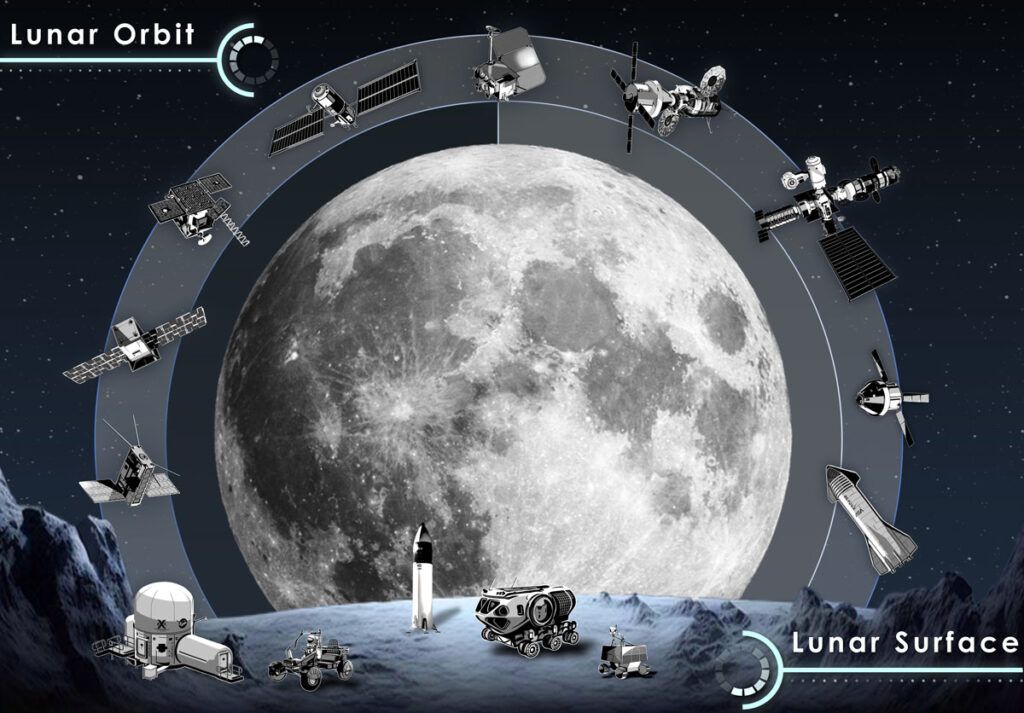
The Artemis era: A new phase in human lunar exploration
To celebrate International Moon Day, the head of ITU’s expert group for space radiocommunication applications reflects on the new age of lunar exploration.
By Cathy Sham, NASA Lunar & Human Spaceflight Spectrum Manager; Chair of ITU-R Working Party 7B
US space agency NASA – the National Aeronautics and Space Administration – recently launched its most powerful rocket ever. On 16 November, Artemis I was propelled into Earth’s orbit by the new Space Launch System (SLS) rocket, carrying the unmanned Orion spacecraft on its maiden mission to the Moon.
Orion reached the Moon, flew 130 kilometres above the lunar surface, and travelled over 2.25 million kilometres during its three-week journey. The craft then re-entered Earth’s atmosphere and splashed down safely in the Pacific Ocean.
These successes of Artemis I have established the space-worthiness of the SLS and Orion. Now, NASA and international partners – including the Canadian Space Agency (CSA), the European Space Agency (ESA), and the Japan Aerospace Exploration Agency (JAXA) – are firmly on a path to usher in a new era of long-term human presence in, on and around the Moon by the end of the decade.
Artemis II will send the first person of colour and the first woman to the Moon, ushering in a new era of human spaceflight. Then, Artemis III will land the first humans on the lunar surface in over 50 years.
As these missions develop, NASA aims to work even more closely with other space agencies and with industry partners to ensure maximum benefits for everyone. Many space agencies that are similarly interested in lunar exploration have recognized the value of early cooperation and coordination, particularly since 2021 through the Space Frequency Coordination Group (SFCG).
The Artemis Accords, with more than 25 signatories to date, are rooted in principles established in the Outer Space Treaty of 1967. Accordingly, they lay out a shared vision of cooperation in the civil exploration and use of the Moon.
This means facilitating lunar exploration, science, and commercial activities for all of humanity to enjoy.
Under the Artemis campaign, NASA and other space agencies are developing spacecraft, surface vehicles, and robotic systems, as well as designing unique scientific experiments to further enhance our understanding of the Universe together.
The aim is to establish a sustainable and robust presence on the Moon in the next decade.
Just like in the Apollo era over half a century ago, innovations envisaged to support a sustained human presence on the Moon could also stimulate breakthroughs that improve life here on Earth.
The United Nations Office for Outer Space Affairs (UNOOSA) has identified numerous ways space exploration can help meet UN Sustainable Development Goals.
Spectrum management on and around the Moon
Lunar exploration was the exclusive domain of government-run space agencies since the 1960s. But this is no longer the case in the Artemis era. Commercially owned and operated landers and rovers are about to arrive, with around 10 such missions expected to land on the lunar surface by the end of 2023.
The companies behind these missions – looking beyond the science traditionally carried out by governmental agencies – are interested in the Moon’s economic potential.
While NASA envisages a sustained lunar presence for science and exploration purposes, other lunar stakeholders are planning robotic mining, radio astronomy, and even tourism ventures.
Mission planners, engineers, scientists, architects, and regulatory experts must work together to ensure adequate radio spectrum access for all users. The demand is growing on, and for, radio frequencies that can be used to send commands to spacecraft, receive mission and health data, and accurately locate resources, systems, and astronauts.

Image: NASA
Cooperation on radio frequency allocations
Starting in 1997, the International Telecommunication Union (ITU) has urged countries to consider the implications of establishing a lunar communications relay system. ITU’s Radiocommunication Assembly posed several questions on frequency bands, bandwidth, orbital requirements, and other operational and technical requirements, along with considerations about sharing with other services.
The ITU Radiocommunication Sector (ITU-R) adopted a new study question in 2022 seeking ways to maintain the protection of radio astronomy services in the Shielded Zone of the Moon (SZM) while considering the critical and essential communications links for system control and data collection.
As radio astronomers develop more detailed plans, the technical and operational characteristics of radio astronomical observation in the SZM, including which frequency bands can be expected to maximize the scientific output, are becoming clearer. Scientists and engineers are also starting to develop ideas about support systems, such as communications platforms to transmit data back to scientists on Earth.
Peaceful relations and orderly international cooperation over space radiocommunication allocations are essential, whether for multinational or commercial missions.
The upcoming 2023 World Radiocommunication Conference (WRC-23) will bring together national administrations, space agencies, and a wide array of technical experts to review and update the ITU’s Radio Regulations. Administrations will also consider topics for the next edition (WRC-27) around four years from now.
Among the many topics, the Report to the Conference by ITU’s Radiocommunication Director invites consideration of determining whether a new requirement should be added in the Radio Regulations to ensure compliance with Regulation Nos. 22.22 to 22.25 on radio astronomy in the SZM.
Additionally, space agencies have come together to support a WRC-27 proposal to study the feasibility of allocations for space research, in order to lay the foundation for successful lunar missions in the decades to come.
NASA and its fellow space agencies envisage continued research to improve human lives and satisfy the human quest for knowledge of our universe. The exploration missions that support such research would not be possible without ITU’s work, which ensures that the valuable resource of the radio spectrum is used in the most effective and efficient manner.
Header image credit: NASA
